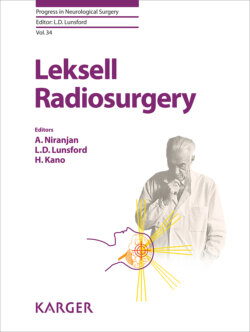Читать книгу Leksell Radiosurgery - Группа авторов - Страница 22
На сайте Литреса книга снята с продажи.
First Look
ОглавлениеDuring the senior author’s training at the University of Pittsburgh (1975–1980), the need for less invasive strategies to diagnose and treat or create brain lesions became apparent. Arriving the same day as the first Pittsburgh computed tomography (CT) scanner – the original Mark 1 EMI with a water bag – I immediately knew that the ability to look inside the brain had radically changed. When that first-generation device was supplemented in 1978 by the first open CT scanner – now a new generation device built by ASE and marketed by Pfizer – the opportunity to actually perform surgery in a diagnostic CT scanner became obvious. In collaboration with the then current chief of neuroradiology, Arthur Rosenbaum, and an engineer, John Perry, from Pfizer, we developed a prototype guiding device using the N-localizer method to define a target with three rectilinear coordinates (X, Y, Z) [1].
Lunsford began researching European centers that were still active in performing stereotactic procedures. No stereotactic procedures were done at our center during the years 1975–1978, at which point we performed CT-guided stereotactic surgery on the first patients using the prototype imaging-compatible device made for the CT scanner [2, 3]. His chairman, Peter Jannetta, secure in his own contribution to neurosurgery and willing to allow innovation from others, allowed Lunsford to spend 3 months in Europe in the Spring of 1979. He spent 6 weeks in Stockholm at the Karolinska Institute at the kind invitation of Erik-Olof Backlund and Lars Leksell. It was there that he observed the first Gamma Knife, built, loaded, and first used to treat a patient at Studsvik, but eventually placed at a private hospital established by the Swedish Royal family (Sofiahemmet). The second Gamma Knife, redesigned to develop a more oblate radiosurgical field suitable for structural brain targets such as tumors and vascular malformation, was installed at the Karolinska Hospital in 1975.
As chief resident in Pittsburgh, Lunsford sucessfully competed for the American Association of Neurological Surgeons (AANS) William P. Van Wagenen fellowship. When I informed Peter Jannetta, he was delighted and offered to both hire me as an assistant professor and to help underwrite that year abroad. Stockholm and the Karolinska were an incredible transition from chief residency in Pittsburgh – almost like taking an academic sabbatical before you start your first academic position. I have never done another or had a better year. The Van Wagenen award was given to me by Eugene Stern in Los Angeles at the AANS business meeting in April 1980 [4]. Stern was not a fan of my chairman Peter Jannetta. There were 6 people present at this first glimpse of the world of neuropolitics.
